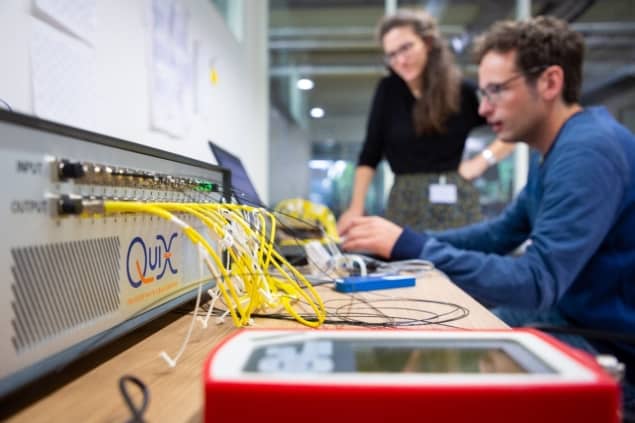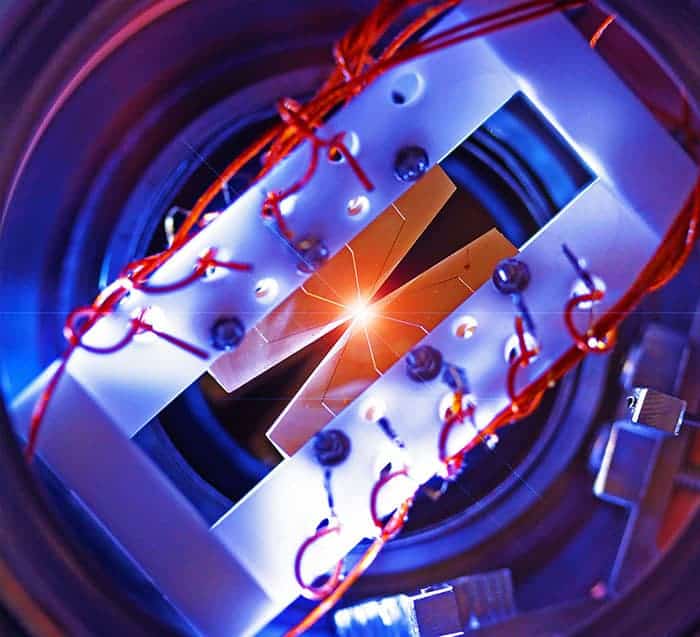
Scientists from QuiX Quantum and the adaptive quantum optics group at the University of Twente in the Netherlands have built the largest universal photonic quantum processor to date. The processor works by applying adjustable phase shifts to the optical signals going through its 12 modes and then merging the signals in adjustable proportions. The precision of its fabrication allows single photons to interfere as they propagate, making the processor capable of quantum operations – albeit not yet at a level that could outperform classical machines.
The new device takes in 12 input optical signals, processes them and outputs the result optically, all at the standard telecommunication wavelength. The device’s photonic configuration – that is, the phase shifts and the proportions of each signal being merged – determines the nature of the processing task, and users can reconfigure this by connecting it to an ordinary personal computer. In this way, the device can be programmed to perform any processing task realizable by a specific set of optical merging and phase shifting steps.
The photonic processor and its delicate engineering
To implement these steps, the device uses a series of optical components known as tuneable phase shifters and tuneable beam mergers. The latter consists of two beam mergers that combine pairs of input beams in equal proportions, plus a tuneable phase shifter. The key to making the system reconfigurable is thus to have full control over the phase shifters within the processor’s photonic circuit, where each of the phase shifters is a heater that induces a very well-tuned and specific change in the effective path length of the passing optical signals via a phenomenon known as the thermo-optic effect.
By satisfying a list of technical demands for the 12 modes, from high-quality microfabrication of the photonic waveguides (optical paths) to providing fast mechanisms for stabilizing the temperature of the photonic circuit, the team set a record for the number of on-chip modes with a programmable configuration that can process quantum optical inputs (such as single-photon ones). In other words, the probability of losing a single photon inside the processor is low, and furthermore, identical single photons injected to different inputs of the processor do not appear different at the output. These results have been published in Materials for Quantum Technology.
Characterizing the processor
To quantify the processor’s reconfigurability, the team changed the processor’s configuration and tested it using laser light (providing classical inputs) and photodetectors. By comparing the configuration obtained in this test with the desired one, they found the “amplitude fidelity” – a measure of similarity between different configurations – was about 93%, stretching to 98% for some target configurations.

The researchers also evaluated the processor’s optical loss with the same input–output setup. They found that this was as low as 17% on average, although a significant amount of additional loss occurs at the input and output connectors. Finally, they characterized the processor’s ability to preserve the identical nature of single photons. The team did this by injecting two identical, single photons simultaneously and observing a phenomenon known as Hong–Ou–Mandel interference at the single-photon detectors connected to the outputs. They found that the on-chip interference has the same visibility as the off-chip interference of the two injected single photons – meaning that single photons at the chip’s output are as identical as they were at the input.
Next steps
Although this processor could, in principle, form the core of an efficient universal optical quantum computer, fabricating the other equipment needed for such a computer would be far more technically demanding. Nevertheless, there is one known computational problem for which a processor of this nature can outperform classical computers (a situation known as “quantum supremacy” or “quantum primacy”) without fancier equipment. This problem is known as boson sampling and it involves predicting the output of the processor itself in a special scenario.
To understand how boson sampling works, consider what happens if we inject some identical single photons into the processor. The photons propagate through the processor and appear at the outputs where they are detected by single-photon detectors. But which detectors will find a photon? This question is inherently impossible to answer. Even if the input and the configuration is exactly the same, different detectors will be activated at the output each time we run the experiment. Nonetheless, if we run the experiment many times, we can prepare statistical samples implying the probability of different detection events. The interesting point here, from a computational point of view, is that for a big enough number of modes, classical computers cannot efficiently prepare these statistical samples (or calculate the probability distribution function for the detection events).

Ion-trap quantum computer is programmable and reconfigurable
In 2020, researchers led by Jian-Wei Pan and Chao-Yang Lu of the University of Science and Technology of China (USTC) demonstrated quantum advantage for a similar problem using their own photonic device. The USTC team’s device differs from the processor described in this study in one critical respect, however. “The authors of the 2020 paper use a static device for their proof-of-principle experiment,” explains Jelmer Renema, a physicist at QuiX Quantum and the University of Twente. “We build on that result and realize full reconfigurability.”
Renema goes on to explain that while the system he and his colleagues developed can run boson sampling experiments, “quantum supremacy doesn’t arise with 12 modes”. Nevertheless, he and other members of the research group, which is led by Pepijn Pinkse, are developing the processor. “We are working on improving the specifications of the system like reducing the optical loss and, furthermore, on increasing the number of modes. We expect to unveil a processor with 50 modes in 2022,” Renema tells Physics World.



